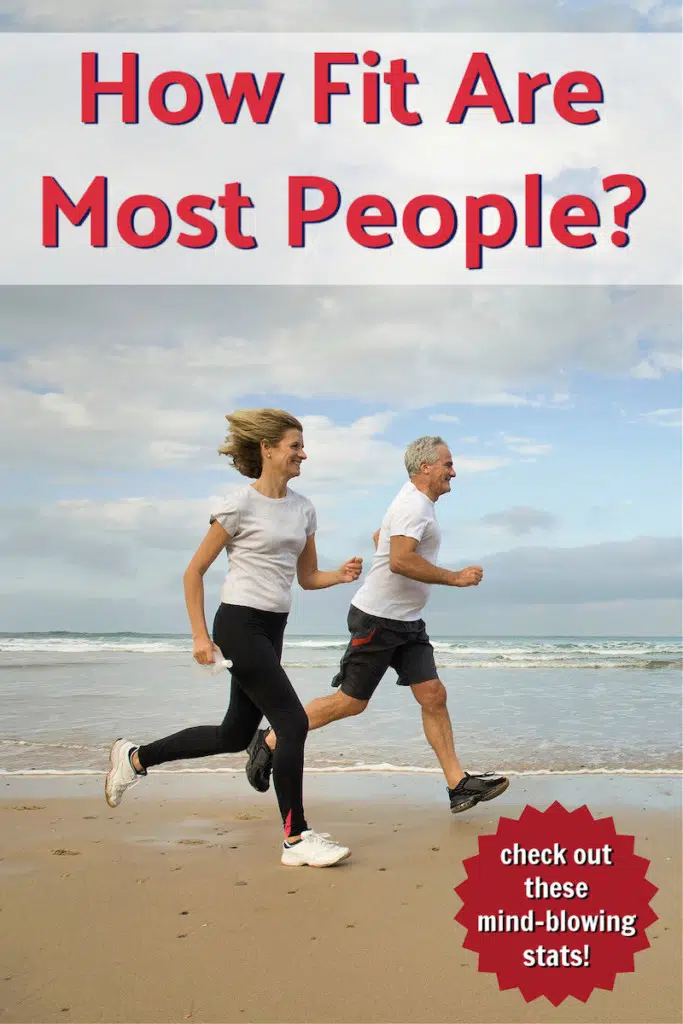How can you tell if you’re fit or unfit? Recent statistics provide valuable clues about your own health – particularly if you happen to be over the age of 50.
Human lifestyles have changed dramatically over the last century. These eight startling statistics show the current state of people’s health – including diet and overall fitness.
These statistics will likely motivate you and guide you to where you can focus your energy to look better, feel better, and become healthier. A video is included that should prove helpful.
Who’s Getting Healthier and Who Isn’t?
Never before have so many health-improving techniques and technologies existed:
- But does everyone have access to these health advancements?
- And for those who do have access, are they availing themselves of the opportunities?
- How fit or unfit are most people today?
Current health statistics have uncovered some surprises.
For instance, the most significant environmental health threat is currently air pollution.
Also, some developed countries that you might think have the lightest disease burden – such as the US – are struggling.
1. Mortality Statistics: 60% of Deaths Are Preventable
Statistics reveal that the causes of death are usually lifestyle-related.
A meta-analysis of 15 studies reveals that approximately 60 percent of premature deaths are due to unhealthy lifestyle factors – such as flawed diets, lack of physical activity, smoking, obesity, and drinking too much alcohol.

Additionally, recent research results suggest healthier diets improve cognition. Clearer thinking leads to better choices which, in turn, might reduce risk of death by accidents. 39% of deaths from unintentional injuries are preventable.
2. Movement Statistics: At Least A Quarter of Adults Over 50 Don’t Exercise
In the US alone, physical inactivity puts over 31 million people at risk of cancer, diabetes, and circulatory disease – and other developed countries aren’t doing much better. This is particularly baffling because most chronic conditions afflicting people over 50 could be prevented or managed with regular physical activity.
3. Cardiovascular Statistics: 32% of All Deaths Worldwide are from Heart Failure
What do the US, the UK, Canada, Australia, and Western Europe (including Germany, Netherlands, and France) have in common? Their leading causes of death are very similar. The leading causes of non-accidental, non-communicable deaths are generally:
- Heart Disease and Cardiac Events
- Cancer
- Stroke
For example, in the US, heart disease and cancer are neck-and-neck as they vie for the top spot on the mortality list. According to the Centers for Disease Control, in 2020, this number of deaths occurred for these specific reasons:
- Heart Disease 696,962
- Cancer 602,350
- Stroke 160,264
Almost 18 million people die each year from heart disease. It is the leading cause of death globally.
Australia provides a slight exception in that dementia, including Alzheimer’s, is nearer the top of their list. Also worth mentioning is that South Africa and India – still listed as developing countries – have tuberculosis and diarrheal diseases near the top of their lists.
4. Coping Statistics: 77% of People Experience Stress that Affects their Physical Health
Statistics on quality of life reveal a distinction between death versus decline.
The problem with revealing statistics about leading causes of death is that most people don’t care much. What do they care about more? Decline.
Though adults don’t expect to live forever, they do hope to enjoy a higher quality of life. That means they’d prefer to avoid the physical pain, exhaustion, and brain fog accompanying many of the top degenerative diseases.
The idea is to live healthy and happy for a long time – and when it is time to die, to do it as quickly and painlessly as possible.
Ironically, much of the anxiety and depression people experience stems from worry about their wellness, which – in turn – negatively impacts their physical health even further. According to the Global Organization for Stress, 77% of people experience anxiety that worsens their health.
This figure varies a bit depending on the specific country. The US has the highest anxiety levels. To add complexity to this issue, some of these stressful worries occur below the level of conscious thought.
5. Eating: 20% Reduction in Sugar Intake Correlates with Nearly 20% Reduction in Disease
Statistics on diets establish that reducing sugar intake improves health outcomes.
Carbs aren’t bad. It’s just that our diets contain too many carbs relative to our activity levels.
Modern humans are more sedentary than they realize. Just because our minds are over-stimulated doesn’t mean our bodies are moving.
Glycation is a term that refers to the damage done to the human body from a bloodstream that is too often flowing with excess sugar.
More than 1 in 3 adults in the US have elevated blood sugar. That’s almost 88 million who have prediabetes. Of those, more than 84% don’t know they have it. Prediabetes puts you at increased risk of developing type-2 diabetes, heart disease, and stroke.
source: Centers for Disease Control and Prevention
Every cell in our bodies, including cancer cells, uses sugar (glucose) from our bloodstream for fuel.
We get that blood sugar mostly from the carbohydrates we eat.
For example, in the US, the average person consumes about 132 pounds of flour yearly.
Worse still, the average per person for sugar is almost 152 pounds (about 70 kilos) in one year.
That’s 6 cups of sugar per week. Most people are not athletic enough to burn off this extra sugar in their bloodstream, and damage is wrought.
A 20% reduction in sugar reduces the severity of many common health conditions by 20%, including coronary heart disease, type-2 diabetes, liver disease, and obesity – and there is possibly an indirect link between sugar consumption and cancer cell growth.
Interestingly, a 20% sugar reduction would also avert $10.3 billion in medical costs by 2035 in the US. These benefits increase proportionally when sugar is reduced by half!

6. Habit Statistics: Lose 9% More Fat by Eating within a Time Window, while Lowering your Risk of Stroke by 11% by Enjoying Tea and Coffee
New statistics on diets disclose that time-restricted eating combined with coffee and tea consumption provides a surprisingly effective health boost.
This particular hack on diets is reasonably easy to do yet can profoundly impact your overall health.
In a randomized controlled trial, overweight adults who ate their calories between 12:00 pm and 8:00 pm – and consumed only water, black coffee, or tea during the 16-hour fasting window lost 9% more fat than the group that ate the same number of calories, only with no time window.
Furthermore, those who drink coffee and tea (instead of just one or the other) reduce their chances of stroke by 11%. Those whose diets include two coffees and two teas daily reduce stroke risk by 32% while significantly reducing their chances of dementia.
7. Physical Activity: Exercise Reduces Death Risk Up to 70%
Good things happen when your habitual workouts include cardio, strength training, and mobility drills.
Medical doctor Peter Attia asserts that exercise is our single most crucial longevity drug. “A well-crafted exercise program geared toward strength, muscle, and cardiorespiratory fitness helps your risk of death go down significantly,” he states. That’s a five-fold reduction in all-cause mortality for those with elite fitness versus those with below-average fitness.
Additionally, mobility moves such as stretching, Pilates, or yoga help to keep your joints supple and healthy.
8. Psychology Statistics: You’re 33% Less Likely To Have a Heart Attack if You Maintain a Positive Mental Outlook
Research has demonstrated an indisputable connection between health benefits and a positive outlook.
Blood pressure, heart disease, obesity, stroke risk, and blood sugar can all be made worse by a negative attitude – or better by a positive one.
According to John Hopkins Medicine researchers, those with a family history of heart disease and an upbeat attitude are one-third less likely to have a heart attack within five to 25 years than those with a more negative outlook.
Anxiety and stress are often the results of repetitive, negative thoughts that loop inside the mind.
Cultivating a positive outlook means identifying those loops as they occur and then gently pivoting to a more positive thought cycle, such as identifying what about your life is working.
Using thought replacement in this way can improve your cheerfulness, energy level, and feelings of satisfaction – and, over time, can also improve your physical health.
Conclusion: “Am I Fit or Unfit?”
You might be trying to ascertain precisely how fit or unfit you are currently.
In this context, the word “unfit” is not a pejorative term but rather a word intended to help you objectively ascertain where your self-improvement opportunities await.
Of course, your medical doctor can help you determine if you’re fit or unfit at the moment.
Possible Signs of Being Unfit
Primary blood lab results from your yearly physicals – such as fasting glucose (blood sugar), cholesterol, and blood pressure readings – provide valuable clues. You might be unfit if any of these tests are above normal ranges. Check out the video:
Additionally, you can gauge your physical energy level when you wake up each morning. Do you lunge out of bed each morning, enthusiastic to begin the day? If you wake up most mornings feeling crappy, you might be unfit.
Too much abdominal fat usually indicates that additional health protocols can be implemented. Does the waistline on your pants feel snugger this year than it did last year? If so, you might be unfit.
Possible Signs of Being Fit
Can you comfortably bend over and touch your toes while keeping your legs straight? If so, you might be fit!
Can you easily carry on a conversation during a brisk walk without sounding breathless? If so, you might be fit!
Have you gone over a year without any back pain or joint discomfort whatsoever? If so, you might be fit!
Finally, a fast way to take a snapshot of your health is simply to look objectively at yourself naked in the mirror – not to shame yourself for not being supermodel-perfect but, instead, to honestly determine how much excess body fat you might be carrying.
How does your health compare to others over 50? Statistics reveal the current state of human health and how to tell if you’re fit or unfit. Health statistics allow you to quickly recognize which interventions will likely have the most significant impact.
The most intelligent ways to improve your own health are mostly the same as they’ve always been – an anti-inflammatory diet, consistent cross-training workouts, and a loving attitude.
Additional Resources for Health Data:
Statistics on Global Causes of Death, Ranked – https://www.who.int/news-room/fact-sheets/detail/the-top-10-causes-of-death
WHO on Single Biggest Health Threat to Humanity – https://www.who.int/news-room/fact-sheets/detail/climate-change-and-health
Death Causes within US – https://www.cdc.gov/nchs/fastats/leading-causes-of-death.htm
Top Causes of Death in UK – https://www.letsgetchecked.com/articles/top-5-causes-of-death-in-the-uk/
Greater Health Benefit from Exercise than Previously Reported – https://news.harvard.edu/gazette/story/2017/11/study-shows-larger-health-benefit-from-physical-activity-than-previously-reported/
Australia Death Causes – https://www.australiawidefirstaid.com.au/resources/leading-causes-of-death
Leading Causes of Death in South Africa – https://businesstech.co.za/news/lifestyle/498579/leading-causes-of-death-in-south-africa-2/
Statistics on Diets and Sugar Consumption (by Country, Ranked) – https://www.worldatlas.com/articles/top-sugar-consuming-nations-in-the-world.html
Data on Disease Burden – https://ourworldindata.org/health-meta#burden-of-disease
Peter Attia on The Best Exercises for Longevity – https://youtu.be/92kYDVjX0G0
Listed as Developing Countries, South Africa and India – https://ideas.repec.org/p/pra/mprapa/80763.html – https://www.bbc.co.uk/bitesize/guides/zgwm4j6/revision/
Diets and Sugar in First-World versus Developing Countries – https://www.fao.org/3/x0513e/x0513e07.htm
Optimism Lowers Risk of Having Stroke – https://news.umich.edu/positive-thinking-optimism-lowers-risk-of-having-stroke/
Map Difference of Northern and Western Europe – https://globalindices.iupui.edu/environment/regions/northern-western-europe/index.html
What is Degenerative Disease? – https://en.wikipedia.org/wiki/Degenerative_disease
Startling Health Study Statistics: 531,804 Participants from 17 Countries with a Follow-Up of 13.24 Years – https://www.ncbi.nlm.nih.gov/pmc/articles/PMC6207481/
Global Heart Disease – https://www.who.int/health-topics/cardiovascular-diseases
Statistics of Death by Unintentional Injuries – https://www.lhsfna.org/cdc-nearly-half-of-u-s-deaths-can-be-prevented/
Extensive Evidence Supports Relationship Between Diets and Cognitive Function – https://www.ncbi.nlm.nih.gov/pmc/articles/PMC6179018/
Sugar and Cancer – https://www.aicr.org/news/the-sugar-cancer-connection/
Statistics of Diets and Food Item Consumption Per Person – https://www.ers.usda.gov/data-products/ag-and-food-statistics-charting-the-essentials/food-availability-and-consumption/
Global Organization for Stress – http://www.gostress.com/
Medical Benefits of Positive Thinking – https://www.nytimes.com/2017/03/27/well/live/positive-thinking-may-improve-health-and-extend-life.html
Positive Outcomes in Health Improvement and Medical Cost Reduction from Less Sugar – https://www.ncbi.nlm.nih.gov/pmc/articles/PMC5577881/
Average Sugar Consumption – https://www.dhhs.nh.gov/dphs/nhp/documents/sugar.pdf
Physical Inactivity in Over Fifty [Data] – https://www.cdc.gov/media/releases/2016/p0915-physical-activity.html
